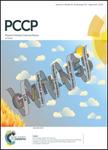版权所有:内蒙古大学图书馆 技术提供:维普资讯• 智图
内蒙古自治区呼和浩特市赛罕区大学西街235号 邮编: 010021

作者机构:Natl Inst Mat Sci Int Ctr Mat Nanoarchitecton MANA WPI Res Ctr Initiat Tsukuba Ibaraki 3050044 Japan Univ Calif Berkeley Grad Program Bioengn Berkeley CA 94720 USA Kanagawa Univ Fac Sci Res Inst Photofunctionalized Mat Dept Chem Hiratsuka Kanagawa 2591293 Japan
出 版 物:《PHYSICAL CHEMISTRY CHEMICAL PHYSICS》 (Phys. Chem. Chem. Phys.)
年 卷 期:2015年第17卷第21期
页 面:14159-14167页
核心收录:
学科分类:081704[工学-应用化学] 07[理学] 070304[理学-物理化学(含∶化学物理)] 08[工学] 0817[工学-化学工程与技术] 0703[理学-化学] 0702[理学-物理学]
基 金:JSPS KAKENHI Grants-in-Aid for Scientific Research [15K21396, 15H03831, 23750093] Funding Source: KAKEN
摘 要:Cell migration is an essential cellular activity in various physiological and pathological processes, such as wound healing and cancer metastasis. Therefore, in vitro cell migration assays are important not only for fundamental biological studies but also for evaluating potential drugs that control cell migration activity in medical applications. In this regard, robust control over cell migrating microenvironments is critical for reliable and quantitative analysis as cell migration is highly dependent upon the microenvironments. Here, we developed a facile method for making a commercial glass-bottom 96-well plate photoactivatable for cell adhesion, aiming to develop a versatile and multiplex cell migration assay platform. Cationic poly-D-lysine was adsorbed to the anionic glass surface via electrostatic interactions and, subsequently, functionalized with poly(ethylene glycol) (PEG) bearing a photocleavable reactive group. The initial PEGylated surface is non-cell-adhesive. However, upon near-ultraviolet (UV) irradiation, the photorelease of PEG switches the surface from non-biofouling to cell-adhesive. With this platform, we assayed cell migration in the following procedure: (1) create cell-attaching regions of precise geometries by controlled photo-irradiation, (2) seed cells to allow them to attach selectively to the irradiated regions, (3) expose UV light to the remaining PEGylated regions to extend the cell-adhesive area, (4) analyse cell migration using microscopy. Surface modification of the glass surface was characterized by zeta-potential and contact angle measurements. The PEGylated surface showed cell-resistivity and became cell-adhesive upon releasing PEG by near-UV irradiation. The method was applied for parallelly evaluating the effect of model drugs on the migration of epithelial MDCK cells in the multiplexed platform. The dose-response relationship for cytochalasin D treatment on cell migration behavior was successfully evaluated with high reproducibi